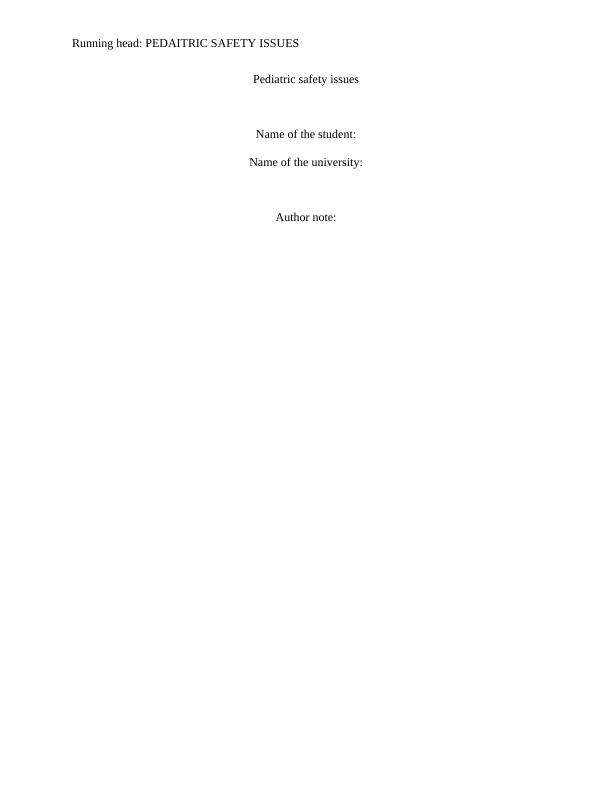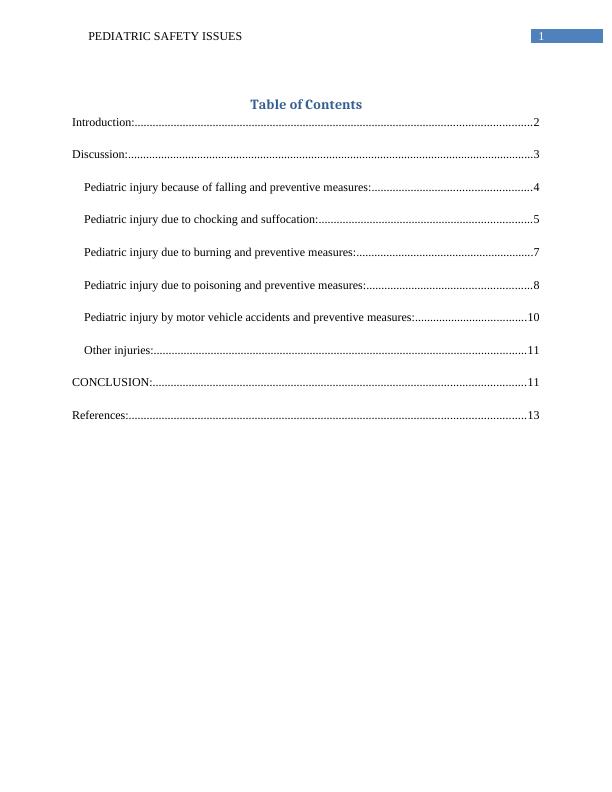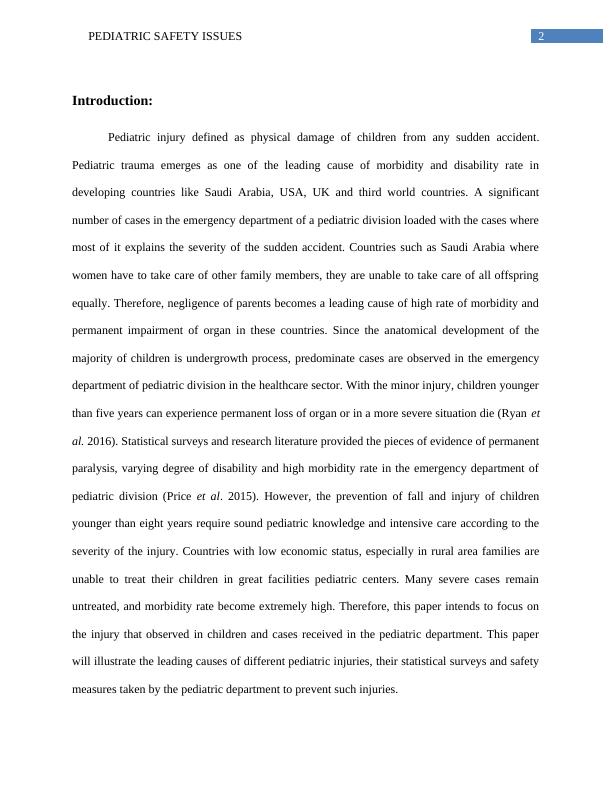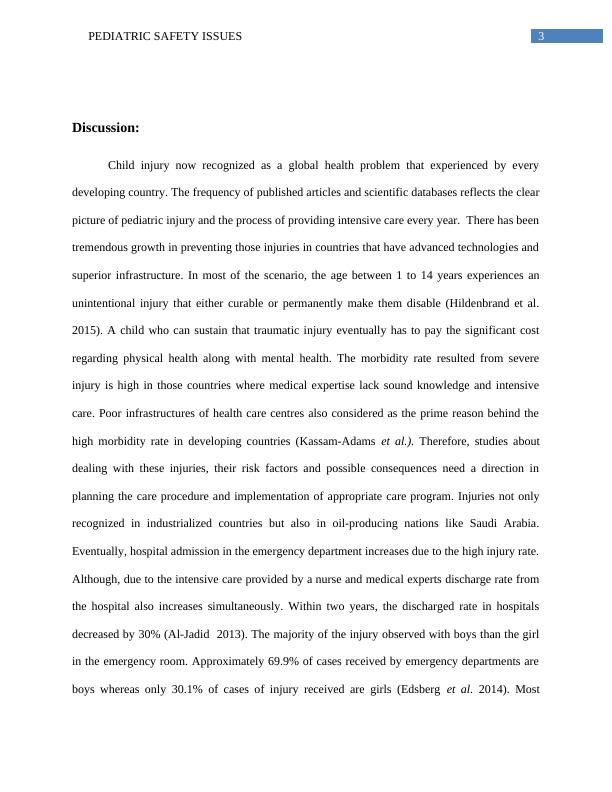Pediatric Safety Issues: Causes, Prevention and Treatment
Added on 2023-06-11
17 Pages5213 Words130 Views
Running head: PEDAITRIC SAFETY ISSUES
Pediatric safety issues
Name of the student:
Name of the university:
Author note:
Pediatric safety issues
Name of the student:
Name of the university:
Author note:

1PEDIATRIC SAFETY ISSUES
Table of Contents
Introduction:....................................................................................................................................2
Discussion:.......................................................................................................................................3
Pediatric injury because of falling and preventive measures:.....................................................4
Pediatric injury due to chocking and suffocation:.......................................................................5
Pediatric injury due to burning and preventive measures:...........................................................7
Pediatric injury due to poisoning and preventive measures:.......................................................8
Pediatric injury by motor vehicle accidents and preventive measures:.....................................10
Other injuries:............................................................................................................................11
CONCLUSION:............................................................................................................................11
References:....................................................................................................................................13
Table of Contents
Introduction:....................................................................................................................................2
Discussion:.......................................................................................................................................3
Pediatric injury because of falling and preventive measures:.....................................................4
Pediatric injury due to chocking and suffocation:.......................................................................5
Pediatric injury due to burning and preventive measures:...........................................................7
Pediatric injury due to poisoning and preventive measures:.......................................................8
Pediatric injury by motor vehicle accidents and preventive measures:.....................................10
Other injuries:............................................................................................................................11
CONCLUSION:............................................................................................................................11
References:....................................................................................................................................13

2PEDIATRIC SAFETY ISSUES
Introduction:
Pediatric injury defined as physical damage of children from any sudden accident.
Pediatric trauma emerges as one of the leading cause of morbidity and disability rate in
developing countries like Saudi Arabia, USA, UK and third world countries. A significant
number of cases in the emergency department of a pediatric division loaded with the cases where
most of it explains the severity of the sudden accident. Countries such as Saudi Arabia where
women have to take care of other family members, they are unable to take care of all offspring
equally. Therefore, negligence of parents becomes a leading cause of high rate of morbidity and
permanent impairment of organ in these countries. Since the anatomical development of the
majority of children is undergrowth process, predominate cases are observed in the emergency
department of pediatric division in the healthcare sector. With the minor injury, children younger
than five years can experience permanent loss of organ or in a more severe situation die (Ryan et
al. 2016). Statistical surveys and research literature provided the pieces of evidence of permanent
paralysis, varying degree of disability and high morbidity rate in the emergency department of
pediatric division (Price et al. 2015). However, the prevention of fall and injury of children
younger than eight years require sound pediatric knowledge and intensive care according to the
severity of the injury. Countries with low economic status, especially in rural area families are
unable to treat their children in great facilities pediatric centers. Many severe cases remain
untreated, and morbidity rate become extremely high. Therefore, this paper intends to focus on
the injury that observed in children and cases received in the pediatric department. This paper
will illustrate the leading causes of different pediatric injuries, their statistical surveys and safety
measures taken by the pediatric department to prevent such injuries.
Introduction:
Pediatric injury defined as physical damage of children from any sudden accident.
Pediatric trauma emerges as one of the leading cause of morbidity and disability rate in
developing countries like Saudi Arabia, USA, UK and third world countries. A significant
number of cases in the emergency department of a pediatric division loaded with the cases where
most of it explains the severity of the sudden accident. Countries such as Saudi Arabia where
women have to take care of other family members, they are unable to take care of all offspring
equally. Therefore, negligence of parents becomes a leading cause of high rate of morbidity and
permanent impairment of organ in these countries. Since the anatomical development of the
majority of children is undergrowth process, predominate cases are observed in the emergency
department of pediatric division in the healthcare sector. With the minor injury, children younger
than five years can experience permanent loss of organ or in a more severe situation die (Ryan et
al. 2016). Statistical surveys and research literature provided the pieces of evidence of permanent
paralysis, varying degree of disability and high morbidity rate in the emergency department of
pediatric division (Price et al. 2015). However, the prevention of fall and injury of children
younger than eight years require sound pediatric knowledge and intensive care according to the
severity of the injury. Countries with low economic status, especially in rural area families are
unable to treat their children in great facilities pediatric centers. Many severe cases remain
untreated, and morbidity rate become extremely high. Therefore, this paper intends to focus on
the injury that observed in children and cases received in the pediatric department. This paper
will illustrate the leading causes of different pediatric injuries, their statistical surveys and safety
measures taken by the pediatric department to prevent such injuries.

3PEDIATRIC SAFETY ISSUES
Discussion:
Child injury now recognized as a global health problem that experienced by every
developing country. The frequency of published articles and scientific databases reflects the clear
picture of pediatric injury and the process of providing intensive care every year. There has been
tremendous growth in preventing those injuries in countries that have advanced technologies and
superior infrastructure. In most of the scenario, the age between 1 to 14 years experiences an
unintentional injury that either curable or permanently make them disable (Hildenbrand et al.
2015). A child who can sustain that traumatic injury eventually has to pay the significant cost
regarding physical health along with mental health. The morbidity rate resulted from severe
injury is high in those countries where medical expertise lack sound knowledge and intensive
care. Poor infrastructures of health care centres also considered as the prime reason behind the
high morbidity rate in developing countries (Kassam-Adams et al.). Therefore, studies about
dealing with these injuries, their risk factors and possible consequences need a direction in
planning the care procedure and implementation of appropriate care program. Injuries not only
recognized in industrialized countries but also in oil-producing nations like Saudi Arabia.
Eventually, hospital admission in the emergency department increases due to the high injury rate.
Although, due to the intensive care provided by a nurse and medical experts discharge rate from
the hospital also increases simultaneously. Within two years, the discharged rate in hospitals
decreased by 30% (Al-Jadid 2013). The majority of the injury observed with boys than the girl
in the emergency room. Approximately 69.9% of cases received by emergency departments are
boys whereas only 30.1% of cases of injury received are girls (Edsberg et al. 2014). Most
Discussion:
Child injury now recognized as a global health problem that experienced by every
developing country. The frequency of published articles and scientific databases reflects the clear
picture of pediatric injury and the process of providing intensive care every year. There has been
tremendous growth in preventing those injuries in countries that have advanced technologies and
superior infrastructure. In most of the scenario, the age between 1 to 14 years experiences an
unintentional injury that either curable or permanently make them disable (Hildenbrand et al.
2015). A child who can sustain that traumatic injury eventually has to pay the significant cost
regarding physical health along with mental health. The morbidity rate resulted from severe
injury is high in those countries where medical expertise lack sound knowledge and intensive
care. Poor infrastructures of health care centres also considered as the prime reason behind the
high morbidity rate in developing countries (Kassam-Adams et al.). Therefore, studies about
dealing with these injuries, their risk factors and possible consequences need a direction in
planning the care procedure and implementation of appropriate care program. Injuries not only
recognized in industrialized countries but also in oil-producing nations like Saudi Arabia.
Eventually, hospital admission in the emergency department increases due to the high injury rate.
Although, due to the intensive care provided by a nurse and medical experts discharge rate from
the hospital also increases simultaneously. Within two years, the discharged rate in hospitals
decreased by 30% (Al-Jadid 2013). The majority of the injury observed with boys than the girl
in the emergency room. Approximately 69.9% of cases received by emergency departments are
boys whereas only 30.1% of cases of injury received are girls (Edsberg et al. 2014). Most

End of preview
Want to access all the pages? Upload your documents or become a member.
Related Documents
Factors Affecting Interprofessional Teamwork in Emergency Care of Poly-Trauma Patientslg...
|10
|3622
|97
Burden of Diseases in Saudi Arabia: Strategies and Challengeslg...
|4
|864
|103
The Aim of Review Paper 2022lg...
|8
|1986
|40
Critical Thinking in Treatment of Traumatic Brain Injurylg...
|12
|3330
|72
Occupational Safety and Health Hazards for Emergency Room Nurseslg...
|15
|4365
|57
Factors Responsible for the Development of Pressure Injurylg...
|8
|2316
|194
